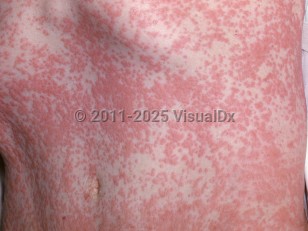Exanthematous drug eruption in Infant/Neonate
Alerts and Notices
Important News & Links
Synopsis

Almost any oral agent can cause an exanthematous reaction, but they are most commonly seen with the use of antibiotics (penicillins and sulfas), allopurinol, phenytoin, barbiturates, chlorpromazine, carbamazepine, d-penicillamine, captopril, naproxen, and piroxicam, but many other drug culprits have been reported, such as older and newer chemotherapeutic agents, including from immunotherapies and targeted therapies (referred to as "maculopapular eruption" in the oncologic literature).
Related topics: cutaneous adverse effects of BRAF inhibitors, cutaneous adverse effects of immune checkpoint inhibitors, cutaneous adverse effects of mTOR inhibitors
Codes
L27.0 – Generalized skin eruption due to drugs and medicaments taken internally
T50.905A – Adverse effect of unspecified drugs, medicaments and biological substances (initial encounter)
SNOMEDCT:
238814003 – Maculopapular drug eruption
Look For
Subscription Required
Diagnostic Pearls
Subscription Required
Differential Diagnosis & Pitfalls

Subscription Required
Best Tests
Subscription Required
Management Pearls
Subscription Required
Therapy
Subscription Required
Drug Reaction Data
Subscription Required
References
Subscription Required
Last Updated:09/17/2025
 Patient Information for Exanthematous drug eruption in Infant/Neonate
Patient Information for Exanthematous drug eruption in Infant/Neonate- Improve treatment compliance
- Reduce after-hours questions
- Increase patient engagement and satisfaction
- Written in clear, easy-to-understand language. No confusing jargon.
- Available in English and Spanish
- Print out or email directly to your patient


